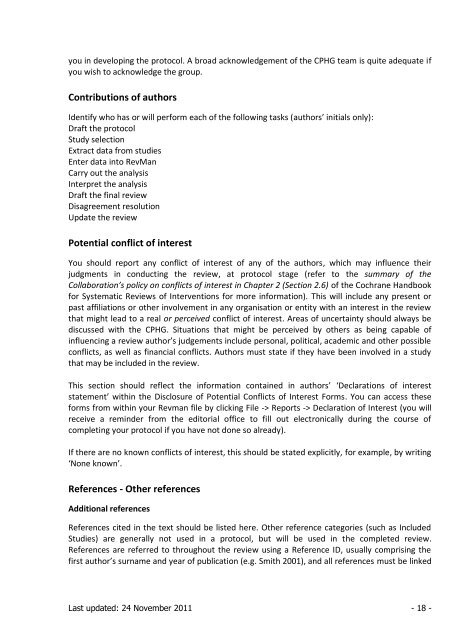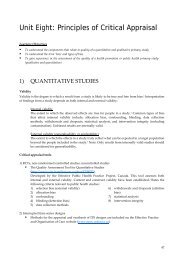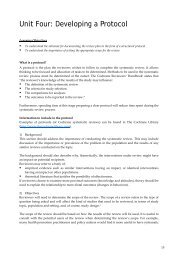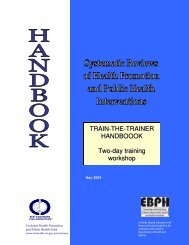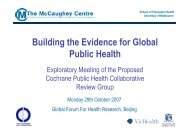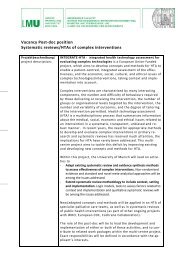Guide for Developing a Cochrane Protocol - Cochrane Public Health ...
Guide for Developing a Cochrane Protocol - Cochrane Public Health ...
Guide for Developing a Cochrane Protocol - Cochrane Public Health ...
You also want an ePaper? Increase the reach of your titles
YUMPU automatically turns print PDFs into web optimized ePapers that Google loves.
you in developing the protocol. A broad acknowledgement of the CPHG team is quite adequate if<br />
you wish to acknowledge the group.<br />
Contributions of authors<br />
Identify who has or will per<strong>for</strong>m each of the following tasks (authors’ initials only):<br />
Draft the protocol<br />
Study selection<br />
Extract data from studies<br />
Enter data into RevMan<br />
Carry out the analysis<br />
Interpret the analysis<br />
Draft the final review<br />
Disagreement resolution<br />
Update the review<br />
Potential conflict of interest<br />
You should report any conflict of interest of any of the authors, which may influence their<br />
judgments in conducting the review, at protocol stage (refer to the summary of the<br />
Collaboration’s policy on conflicts of interest in Chapter 2 (Section 2.6) of the <strong>Cochrane</strong> Handbook<br />
<strong>for</strong> Systematic Reviews of Interventions <strong>for</strong> more in<strong>for</strong>mation). This will include any present or<br />
past affiliations or other involvement in any organisation or entity with an interest in the review<br />
that might lead to a real or perceived conflict of interest. Areas of uncertainty should always be<br />
discussed with the CPHG. Situations that might be perceived by others as being capable of<br />
influencing a review author’s judgements include personal, political, academic and other possible<br />
conflicts, as well as financial conflicts. Authors must state if they have been involved in a study<br />
that may be included in the review.<br />
This section should reflect the in<strong>for</strong>mation contained in authors’ ‘Declarations of interest<br />
statement’ within the Disclosure of Potential Conflicts of Interest Forms. You can access these<br />
<strong>for</strong>ms from within your Revman file by clicking File -> Reports -> Declaration of Interest (you will<br />
receive a reminder from the editorial office to fill out electronically during the course of<br />
completing your protocol if you have not done so already).<br />
If there are no known conflicts of interest, this should be stated explicitly, <strong>for</strong> example, by writing<br />
‘None known’.<br />
References - Other references<br />
Additional references<br />
References cited in the text should be listed here. Other reference categories (such as Included<br />
Studies) are generally not used in a protocol, but will be used in the completed review.<br />
References are referred to throughout the review using a Reference ID, usually comprising the<br />
first author’s surname and year of publication (e.g. Smith 2001), and all references must be linked<br />
Last updated: 24 November 2011 - 18 -


